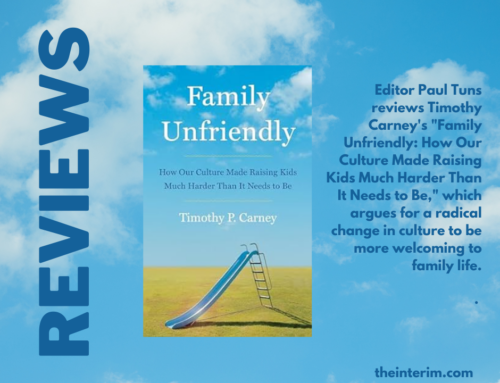Paul Tuns, From the editor’s desk:
Christine Rosen, senior writer for Commentary, wrote the magazine’s January cover story, “The New Misogyny,” on how women are denigrated by the transgender ideology. Under the guise of a “liberationist philosophy,” she writes, this “progressive” spirit is actually “an audacious form of woman-hatred” that “comes in the guise of opening up womanhood.” This new misogyny “insists that being female isn’t an essential biological fact but a mutable identity, something anyone can be.” Doing so, however, requires erasing actual womanhood from our memories so that everyone will play make-believe with those that cast themselves as women despite being born with male organs. Rosen does not seem terribly upset by the fact, as she admits, the “cultural battle has largely been settled in favor of greater acceptance of fluidity in gender expression.” The problem, as Rosen sees it, is that the trans-rights movement insists “there is no such thing as a woman.” If there is no such thing as a woman, how can a man believe he is one? One would assume that a person who (wrongly) identifies as a member of the sex to which they share not physiological similarities, must think that there are some female attributes that they must possess, but this is impossible if “woman” does not exist as a definable characteristic. Regarding this, an exchange between a trans-activist and the Christian apologist Matt Walsh last month on Dr.Phil is instructive: Walsh asked for the definition of what a woman is and the activist responded saying it is whatever a person who identifies as one says it is – a tautology that effectively tells anyone who accepts the physiological certainties of male and female to shut up.
Rosen does as good as job any modernist could in dissecting the problem of the transgender ideology effectively erasing women or reducing them to biological essentials like the ludicrous description of woman as “bodies with vaginas.” Rosen quotes Colin Wright, who wrote in Quillette, that as more people self-identify as any number of untraditional genders (trans, two-spirited, non-binary, gender-non-conforming), “there’s been a push to realign the objective reality of biological sex to match one’s subjectively experienced gender identity” and “in the emerging view, the very notion of males and females existing as real biological entities not seem obsolete.” Which still raises the issue of that if male and female do not exist, how can people identify as the opposite sex or define themselves in relation (“gender-non-conforming”)? This is all so much nonsense and as we’ve reported in this paper in the past, it infects schools and universities, the medical establishment and the corporate world, the legal system and our politics. If this were merely a weird subsection on Twitter or Reddit, it could be dismissed as relatively harmless, but it is taking hold throughout our institutions and, as Rosen observes, “embracing this is not optional.” The Interim was informed by HootSuite, a platform that helps manage social media posts, that we cannot post stories about conversion therapy. But as we promised you, we will call things by their proper names and not entertain the delusions of those suffering from gender confusion or their militant allies that insist we all go along with the radical transformation of words and concepts.
**
In Oklahoma, pro-abortion Democratic State Representative Forrest Bennett, introduced a bill that would require a father of a preborn child to financially support the child and mother. Bennett had a snarky tweet announcing his bill: “If Oklahoma is going to restrict a woman’s right to choose, we sure better make sure the man involved can’t just walk away from responsibility.” It’s about time! Research shows that many women seek abortions because of a lack of support (not just financial) from partners. This policy, though, will help vulnerable women choose to carry their child to term. Still, Bennett faced a backlash from pro-abortion activists who saw it as conceding important ground to the pro-life argument that life begins at conception. Bennett apologized and vowed to reword his bill, but stressed that it was a response to the state enacting pro-life legislation in 2021. Bennett was reacting to a trio of bills signed by Oklahoma Governor Kevin Stitt last April and which would have taken effect in November had courts not enjoined them from being implemented. Stitt signed a so-called heartbeat ban banning most abortions after a fetal heartbeat can be detected at around six weeks gestation. He also signed a bill that would ban abortions outside of medical emergencies and one that would require abortionists to be board certified obstetricians and gynecologists (thereby preventing non-doctors from prescribing the abortion pill). It says a lot about the pro-abortion movement that it cannot acknowledge the straightforward science that the preborn life is human even if the goal is to make men support the mother; indeed, it points out that the only “choice” the supposedly pro-choice side wants is abortion.
**
In December, Toronto joined Vancouver in moving in the direction of decriminalizing drugs; not just marijuana, but all drugs. Following the advice of Eileen de Villa, Medical Officer of Health for the city of Toronto, the board of health voted unanimously to ask the federal government to exempt city residents from criminal charges for possessing small amounts of illegal drugs – drugs such as cocaine and heroin. The Toronto Star reported that this was just common-sense: “For those on the ground who have seen the consequences of a drug poisoning crisis still plaguing the city with overdoses and deaths, decriminalization is the next logical step in a deliberate approach to tackling addiction as a health-care issue, while also changing the over-policing of Black and Indigenous people.” Oh, my. It sounds more like abandoning vulnerable communities to drugs rather than helping them with addictions. In 2005, the Toronto Drug Strategy to “reduce stigma” and increase harm reduction programs to prevent overdoses had the predictable outcome of reducing stigma and increasing overdoses. Harm reduction sounds great in theory (drug addicts need medical interventions not time in jail but they fear arrest if they seek help), but in practice, once the stigma is removed from taking drugs, it is hard to move people into treatment programs. Few jurisdictions that signal a tolerance for using illicit drugs actively try to get addicts off drugs; safe injection sites and other “harm reduction” strategies inevitably end being drug-use increase strategies. This is a gigantic step backward and one that harms those in desperate need of treatment. Policing is not the best way to intervene in the tragic lives of those suffering drug addictions and medical intervention is underfunded and needs more resources; we need not signal societal approval of drug use to get people into rehabilitation programs. How many more cities will merrily go down this destructive path in the name of progress?
**
I came across this quote by St. Francis de Sales at Theology of Home and thought it was worth noting: “We shall steer safely through every storm, so long as our heart is right, our intention fervent, our courage steadfast, and our trust fixed on God.” This is true in all our endeavours, but it is worth reminding ourselves that our work in the pro-life movement must be rooted in prayer and an understanding that the battle to restore a Culture of Life is God’s project, not ours.




